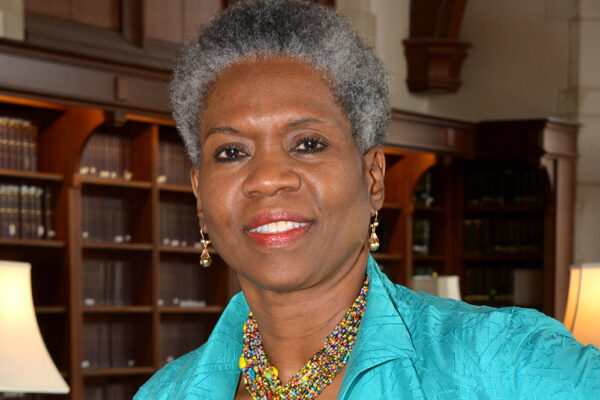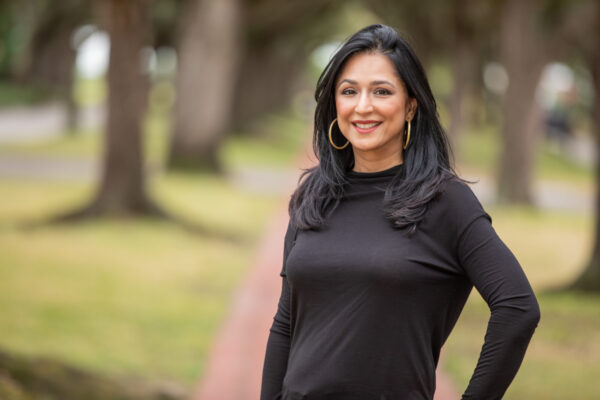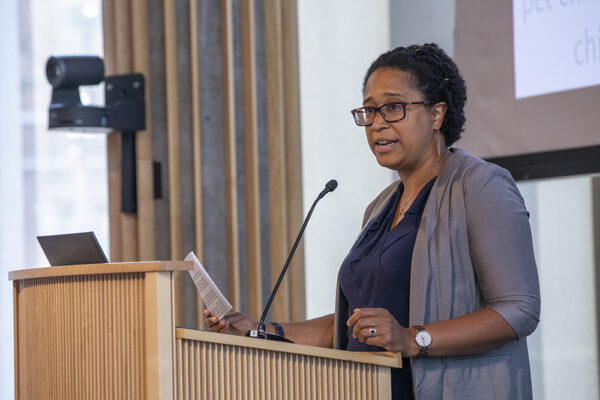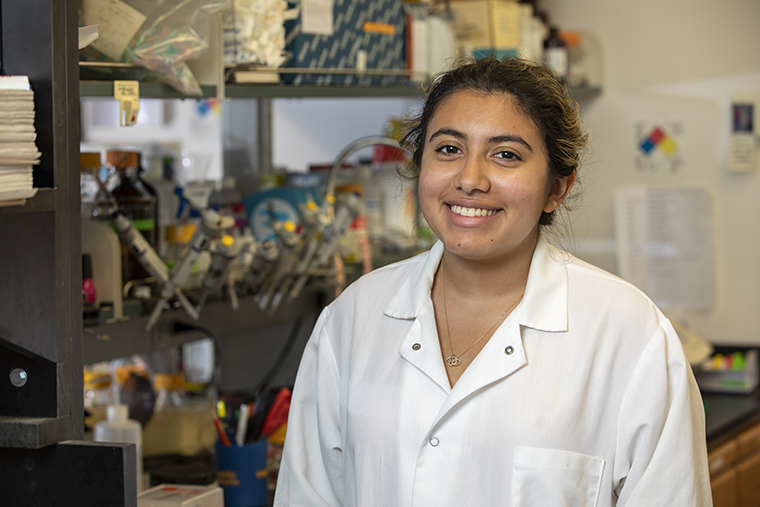
When Washington University in St. Louis student Sneha Chaturvedi walks into a laboratory, she knows what to expect: sterile white floors, test tubes lining the shelves, a chemical smell wafting between benches and men in lab coats. Few of the scientists are women or underrepresented minorities — African-American, Latino, Native American and so on — in other words, scientists like her.
It’s discouraging but not surprising to Chaturvedi, a junior in biology in Arts & Sciences from Miami, who said she often encountered similar situations since she declared her major early in her first year, with her sights on the neuroscience track.
Along with the appeal of rapid innovation, “I decided to study neuroscience both as my major and in my lab because neuroscience can be very interdisciplinary,” Chaturvedi said. “The brain impacts so many different aspects of the body and is also responsible for so many higher-level functions such as memory and learning.”
Yet despite her academic excellence and strong passion to begin her research career, she didn’t always feel readily supported at the undergraduate level as a woman of color in STEM. And unfortunately, her feelings were not singular.
“WashU has a few student-run organizations for women and minorities in STEM, which I feel like could use more support and advertising to students,” Chaturvedi said. “There are resources to go to, but I personally had to go looking for them.”
One research program for neuroscientists is seeking to change that. Now in its fourth year, ENDURE is a pipeline program that prepares undergraduates from diverse backgrounds for neuroscience PhD programs. Supported with funds from the National Institute of Neurological Disorders and from Washington University, the program draws students from universities across the nation as well as Washington University.
Erik Herzog, professor of biology and head of the laboratory where Chaturvedi works, is the program’s director. He said ENDURE offers talented students an opportunity to both produce cutting edge science and meet the neuroscientists who are pushing the field forward. Participants work for two summers in a neuroscience lab and present at the Society for Neuroscience national convention each November.
“The aim is to support students by providing them with research experience, a network of friends and colleagues, and opportunities to master their ability to communicate their findings,” said Herzog, whose own lab employs a diverse research team. “Sneha takes pride in her Latina and Indian heritage. She brings a wonderful, positive energy and challenges me with terrific questions about what next.”
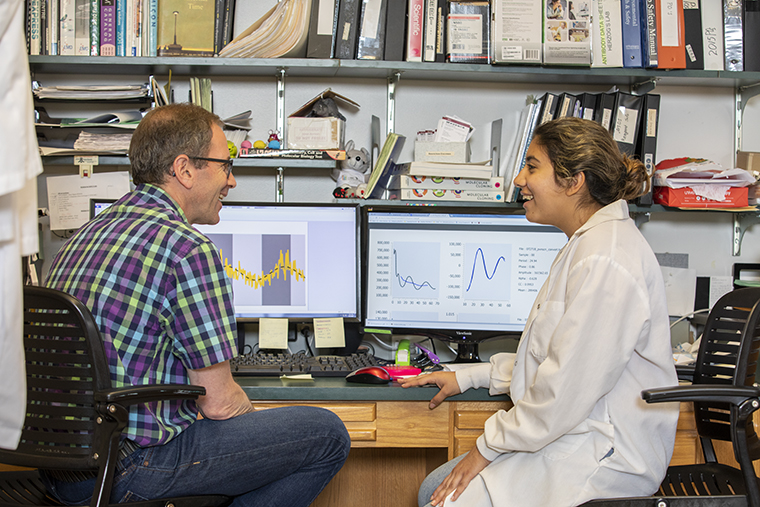
Though Chaturvedi joined ENDURE the summer after her sophomore year, she started work in the Herzog Lab as a first-year student. She designed a research project that tests how circadian rhythms impact the release of glucocorticoid, a stress hormone, and how levels of this hormone differ between sexes.
“One of the biggest things I have learned this summer is how to be an independent researcher working on a project and deciding what should be done each day, which will help me a lot in the future,” Chaturvedi said.
But research experience is not ENDURE’s only benefit. Herzog attributes the program’s success to its strong focus on community. He makes it a priority for students to be able to interact with successful minority researchers to prove that it has been done before; that there is a path and place for them.
Chaturvedi appreciates the mentorship she receives from her “Wire Together Fire Together (WTFT)” buddy — the name of the support group itself is a play on the way that neurons in the brain communicate with each other. All participants are paired with a graduate student buddy who shares their research interests and hobbies.
Chaturvedi’s graduate student mentor is Sindhu Manivasagam, a woman of color pursuing an MD/PhD degree in neurology, who also happens to share Chaturvedi’s love of hiking.
With her WTFT buddy, she can easily rave over neuroscience findings and each other’s research. But Chaturvedi said she also feels comfortable discussing any concerns about pursuing a field where the majority of people hired into faculty and post-graduate research roles have few similarities with her.
“She is there as a resource to help me navigate a primarily white, male-dominated field,” Chaturvedi said. “Just knowing she is there is reassuring.”
According to the National Center for Education Statistics, 34 percent of STEM doctorates were awarded to women in 2015, the latest year for which statistics are available. Of these recent doctorate degrees, only 5.65 percent were awarded to women of color. While half of all biology graduate students are women, a study by MIT shows that only 18 percent of the nation’s full professors of biology are women.
“When the statistics are daunting, a connection between similar people is crucial in giving students the feeling of accessibility to graduate school and future careers,” said Diana José-Edwards, ENDURE program coordinator.
This summer, nine new students joined ENDURE, adding to last year’s 10. Two returned to complete their second summer of research, and the other eight either graduated or are continuing research at another university.
Because the program is small and specialized, program leaders José-Edwards and Herzog can hone in on advising each student with one-on-one sessions outside of scheduled meetings. The students also have individual meetings with Rochelle Smith, an assistant provost who specializes in supporting diversity in STEM.
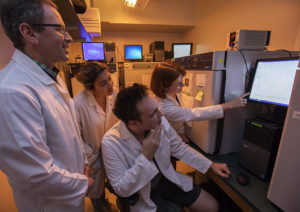
“They really make an effort to talk to us when they see us and check in with how we are doing, which would be harder with a larger program,” Chaturvedi said. “I feel like my close relationship with Professor Herzog has really bolstered my confidence in my projects.”
And Herzog said Chaturvedi has grown tremendously as a researcher and will leave Washington University poised to pursue her interests in neuroscience research and neurosurgery.
“Sneha will graduate after just three years of classes at Washington University with a major in neuroscience, a research thesis and experience shadowing in neurology,” Herzog said.
All this, and good friends, too. To further build their community of like-minded researchers, ENDURE students live together in Washington University residence halls along with students from BioMedRAP and the Amgen Scholars Program — other undergraduate research programs specific to biology.
After a long day at the lab, they can come home to friends and discuss how their day went, their successes and failures, and know the people surrounding them will understand exactly what they are talking about.
“I don’t need to change my language,” Chaturvedi said. “ I can just geek out about the subject and share career goals in the same field.”

